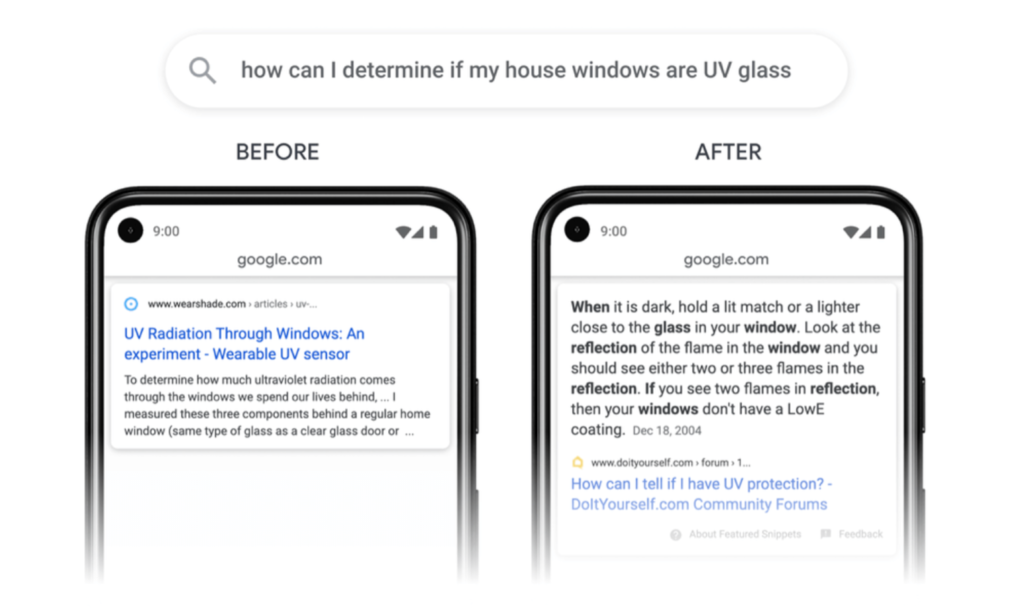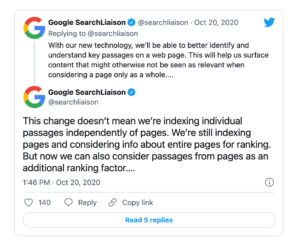When Google first announced the impending roll-out of its passage-based indexing update, it created a bit of a stir in the digital marketing community. The biggest concern centered on assumptions that it would usher in a new era of rules for SEO practices.
Fast-forward to now – more than a year after the update – and it’s clear that passage-based indexing didn’t have quite the Armageddon-level impact some SEOs feared. The change actually represents a heavier lift for Google’s algorithm than for website owners, but there are some key impacts that are helpful for content marketers and others responsible for SEO to understand.
This post is intended to give you a better grasp of passage-based indexing: what it is, what it isn’t, and how it affects SEO. We’ll also get into some specific actions you can take that will not only optimize your site for passage-based indexing, but also enhance overall SEO practices.
What is passage-based indexing?
Rather than a sweeping change, passage-based indexing is a minor tweak to Google’s algorithm that gave the search engine new ability to understand the relevancy of specific passages within a webpage. The overall content of a page may not match a search query, but Google can now identify key bits of information within specific passages that directly answer the question.
“By better understanding the relevancy of specific passages, not just the overall page, we can find that needle-in-a-haystack information you’re looking for,” states Google’s blog.
Here’s a little compare-and-contrast from Google that has been re-run many a time because it illustrates the concept quite well:

Side-by-side: See how passage-based indexing compares to traditional indexing.
On the left, we see search results prior to passage-based indexing, showing a broad page match for the query “how can I determine if my house windows are UV glass.” On the right, with passage understanding capabilities, Google ranks another webpage’s specific passage that contains super-relevant information that answers the query.
Oh and wait, it’s actually “Passage Ranking”
As it turned out, some of the hubbub involved confusion over whether Google would now, as suggested by the name “passage indexing,” index individual passages separately on SERPs (search engine results pages). Nope, Google said, and stated that “passage ranking” was a more accurate description of the change.
Danny Sullivan, Google’s public liaison of search, clarifies this well via Google SearchLiaison, the Twitter account he launched to help people understand how Google’s search engine works:

Tweet from Google’s SearchLiaison
Semantics, yes, but useful to help content marketers better understand what the change is all about.
Featured Snippets is a different thing
One more thing to mention before getting into some SEO impacts and optimization tips: passage-based ranking results may look similar to Google’s Featured Snippets, but they aren’t the same.
The main difference is tied to passage-based indexing’s ability to surface useful information within a web page that might otherwise not be relevant to the query, while Featured Snippets identifies the most relevant passage within a page that has been determined to match the query.
How does passage ranking affect SEO?
Although it doesn’t affect SEO in a major way, there are some impacts content marketers should be aware of:
- Sites with long-form content could see slight gains in traffic.
- Sites with shorter-form content could see small decreases.
- Sites with weak optimization but strong content that addresses user intent could rank higher.
The algorithm update helps the search engine better understand websites with longer, perhaps less well-structured content. If your gut reaction is that Google is rewarding crappy websites that have a poor UX, that’s not necessarily the intent – passage-based indexing is another move Google made in the name of improving the experience for web users. Google estimated that passage indexing would improve results for around 7% of search queries among U.S. English language searches.
Content marketers should view passage indexing as another indicator that Google prefers high-quality, information-rich content. In the words of digital marketing thought leader Neil Patel:
“Optimization is no longer enough to carry mediocre content.” BOOM.
These tips can help you optimize for passage ranking
Passage-based ranking doesn’t mean you need to overhaul your entire website. (Unless it sucks.) Instead, assess your overall content approach, and make sure you’re checking the boxes on having a well-optimized site.
On a high level, assess how well your site meets Google’s top page-level ranking factors. How holistic is your content – do main topic pages cover all the subtopics and key questions a user might have? If you haven’t yet forayed into long-form content, you may want to work it into your approach.
On a more granular level, consider these tips to help take advantage of passage ranking:
- Update long-form articles. Refresh any long-form content that’s been around for a while (e.g., find current statistics, fix outdated links).
- Write keyword-rich headings. Include keywords in headings and subheadings that are indicative of the content they umbrella.
- Optimize specific passages. If you include a section on a page that’s related to the overarching topic but deviates a bit, make sure to optimize that passage with a descriptive subhead and key search terms for that information. Let’s say you have a topic page covering best practices to preserve the life of an industrial laundry machine, and one of the tips ends up veering into some crucial worker safety information. Call it out with a subhead, and weave in specific queries that users would search on to find that information.
- Don’t let overall on-page SEO slip. As mentioned earlier, even though it seems like passage-based indexing will end up prioritizing sites with poor on-page optimization, websites with good content and good on-page optimization will still rank highest, according to Google. In particular, on-point headings and optimized anchor text will help.
- Address both broad and specific questions in long-form content. What does this look like in practice? Let’s say you have a topic page about hiring in the food service industry. Pretty broad, right? Think about specific questions users might have related to that topic, e.g., how to manage benefits for food service workers, what are competitive wages for front-of the-house workers – and address them with specific passages.
- Level up your long-tail keyword approach. Research longer niche queries your target audience is using for your topic and integrate those into site content.
- Identify user intent and incorporate into your keyword strategy. Identifying user intent – the main goals a searcher has when entering a query relevant to your content – is an important aspect of keyword strategy. It’s critical to optimizing for passage ranking because pinpointing user intent can help you craft a more holistic content strategy that addresses key user questions. Here are some tools that can help you uncover user intent:
- Google Suggest: This is that thing that happens when you start typing in a search and Google autocompletes your query. Try typing in some broad search terms for your site and see how Google fills in the blanks – you can gain some decent insight into searches connected to your main topic.
- Check out the “People also ask” and “Related searches” widgets for inspiration. These appear on SERPs and provide good clues on related questions and topics your target audience is searching for.
- Content creation support tools like SEMrush, Ahrefs and Moz, to name a few, can help you uncover user intent and pinpoint subtopics and the most commonly queries.
Bottom line? Passage-based indexing doesn’t mean you need to make crazy adjustments to what you’re already doing SEO-wise. Don’t believe anyone trying to sell you on forking over massive budget to optimize for passage ranking. And although passage ranking is designed to unearth specific content from pages that might be poorly structured, don’t rely on this feature to boost rankings – put the time into creating high-quality content and maintaining a well-optimized site.











